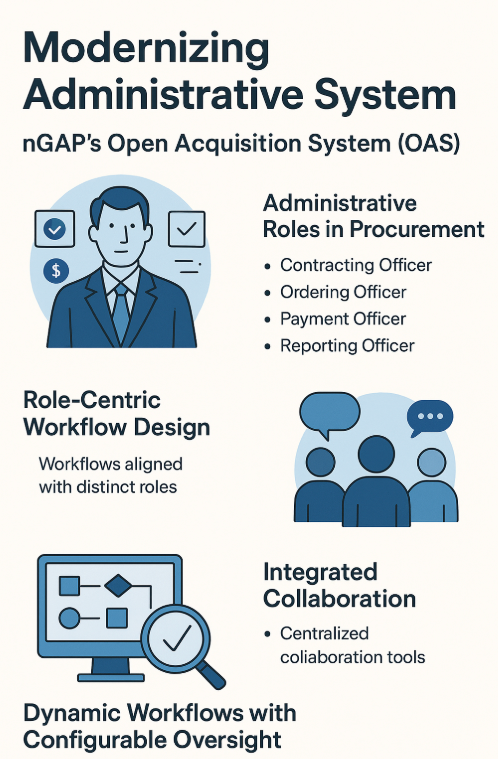Administrative Roles Insight
- nGAP Inc
- Jul 21
- 3 min read

In the complex world of government procurement, administrative roles and functions are the backbone of accountability, compliance, and operational success. Yet, legacy acquisition systems — often fragmented, outdated, and siloed — have historically made these administrative tasks inefficient, opaque, and vulnerable to errors. A solution would be nGAP Inc.’s Open Acquisition System (OAS): a next-generation procurement platform designed to reengineer the way administrative functions are defined, managed, and executed across the federal acquisition lifecycle.
Administrative Roles in Procurement: A Brief Overview
In traditional procurement workflows, several key administrative roles are essential:
Contracting Officer (CO): Has legal authority to enter, administer, or terminate contracts.
Ordering Officer: Issues task or delivery orders under existing contracts.
Payment Officer: Ensures invoice validation, approval, and disbursement.
Reporting Officer: Tracks performance, compliance, and spending trends.
Requisitioner: Initiates and justifies the need for goods or services.
COR (Contracting Officer’s Representative): Oversees contractor performance and ensures compliance.
Each of these roles carries distinct responsibilities. But in many legacy systems, administrative functions tied to these roles are disconnected, non-standardized, and difficult to audit.
How OAS Transforms Administrative Functions
nGAP Inc.’s Open Acquisition System (OAS) is not just a software tool — it is an administrative modernization platform. It introduces several innovations that reshape how administrative roles function and collaborate:
1. Role-Centric Workflow Design
Unlike legacy systems, where permissions are generic or unevenly enforced, OAS defines role-based access and workflow stages tied explicitly to federal procurement rules (e.g., FAR, DFARS). Each user's interface and tasks are streamlined to match their designated authority and responsibility.
For example:
A Contracting Officer sees compliance checks, contract modification tools, and FAR-driven templates.
A Requisitioner accesses simplified purchase request forms with embedded approval logic.
A Reporting Officer receives real-time dashboards without needing to request manual data exports.
2. Integrated and Auditable Collaboration
Legacy systems often separate actions into different platforms (email, spreadsheets, shared drives). OAS centralizes collaboration with:
Built-in approvals and digital signatures
Automated audit trails
Inter-role messaging tied to documents or transactions
Every action by an administrative user is logged, traceable, and reportable — ensuring better transparency and accountability.
3. Dynamic Workflows with Configurable Oversight
Traditional systems have rigid workflows that require costly customizations. OAS offers modular, configurable workflows that adapt to agency-specific processes. This is particularly powerful for administrative supervisors who can:
Set delegation limits for junior officers
Approve exception paths based on threshold rules
Receive alerts when SLAs or procurement integrity boundaries are at risk
4. Data-Driven Administrative Decisions
OAS empowers administrative roles with real-time analytics and compliance monitoring. For instance:
Payment Officers can view contract burn rates against obligation ceilings.
COs can detect duplicate vendors or pricing anomalies across departments.
Reporting Officers can generate automated 508-compliant reports for Congress or internal audits.
Legacy systems typically require data to be exported and manually massaged — increasing error rates and delaying decision-making.
Why OAS Is Better Than Legacy Systems
Feature | Legacy Systems | Open Acquisition System (OAS) |
Role Customization | Static and often hard-coded | Fully configurable with granular permissions |
Auditability | Manual logs or separate systems | Built-in automated logs for every action |
Collaboration | Disconnected (email, Excel) | Unified with chat, tagging, tasking |
Workflow Flexibility | Requires custom dev work | Drag-and-drop or rule-based configuration |
Real-Time Reporting | Limited or delayed | Instant dashboards and compliance checks |
System Updates | Annual or quarterly | Cloud-based with rapid iteration and FedRAMP compliance |
Conclusion

nGAP Inc.’s Open Acquisition System (OAS) is not just a technological upgrade — it’s a structural rethinking of how administrative procurement roles should function in the modern era. With smarter workflows, centralized collaboration, and built-in transparency, OAS empowers federal acquisition professionals to focus on mission outcomes instead of wrestling with archaic tools.
As government agencies seek to modernize and optimize procurement in line with initiatives like the Federal Acquisition Modernization Agenda, OAS stands out as a model for how software should enhance — not complicate — administrative functions.